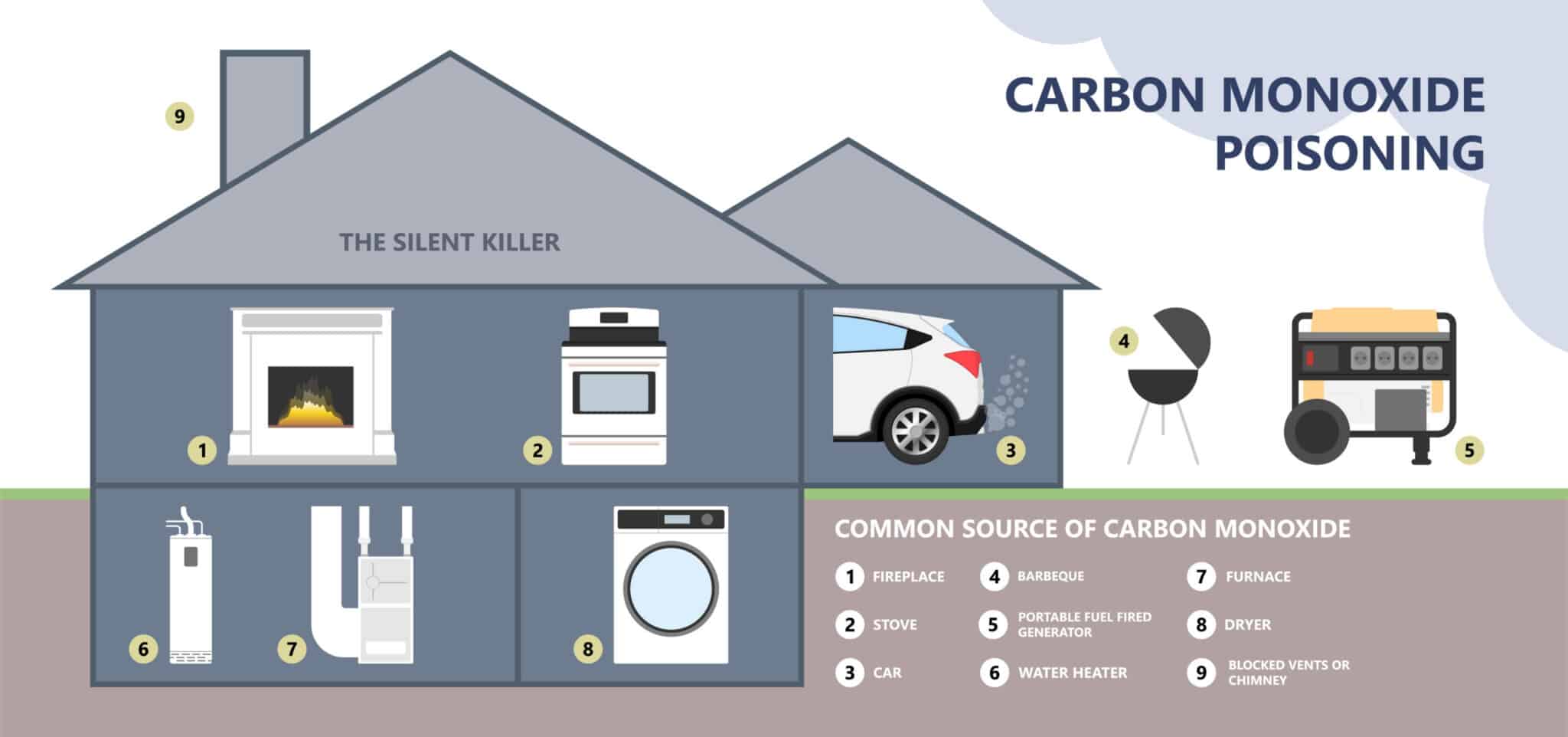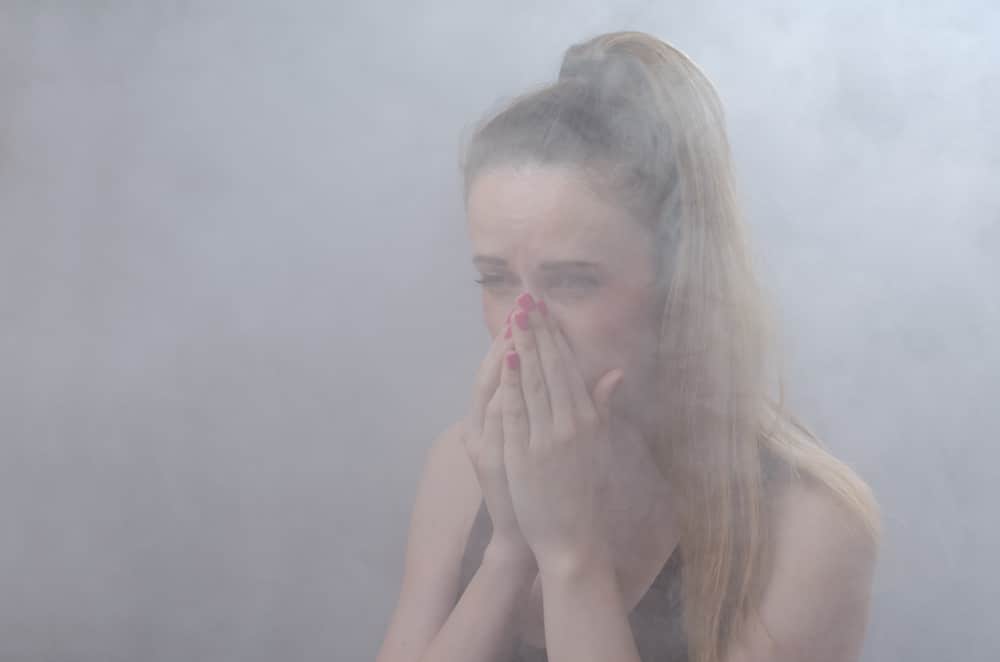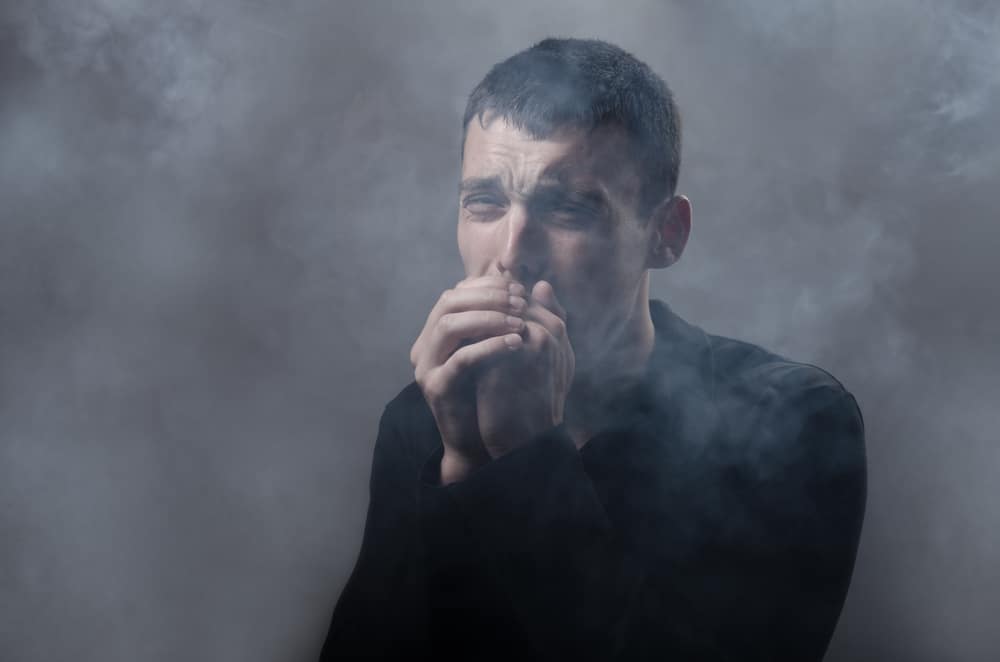When it comes to dangers in our home, one of the few things we think about is carbon monoxide. We focus on falling hazards, electricity issues, fire and flooding. But when was the last time you considered your heating and furnace? When was the last time you considered whether or not it is leaking a silent, toxic fume into your home? Today we are going to discuss answer question like “is carbon monoxide dangerous” and more to keep you and your home safe, and what to do if you think you have a leak.
What is Carbon Monoxide?
Carbon monoxide (CO) is a poisonous, colourless, odourless, and tasteless gas. Although it has no detectable odour, CO will often mix with other gases that do have an odour. So you can inhale carbon monoxide right along with gases that you can smell and not even know that CO is present. CO is a common industrial hazard resulting from the incomplete burning of natural gas and any other material containing carbon such as gasoline, kerosene, oil, propane, coal, or wood. Forges, blast furnaces and coke ovens produce CO, but one of the most common sources of exposure in the workplace is the internal combustion engine.
“All types of gas heaters, including central heating units, space heaters, wall units and gas log fires, should be serviced a minimum of every two years by a licensed gasfitter who has completed training on detecting and correcting risks of carbon monoxide spillage.” (Source: health.vic Department of Health & Human Services, State Government of Victoria.)
Is Carbon Monoxide Dangerous?
The short answer is: Yes! Absolutely. The long answer? Carbon monoxide is incredibly harmful when breathed in because it displaces oxygen in the blood. This deprives the brain, heart, and other vital organs of oxygen. Large amounts of carbon monoxide can overcome you in mere minutes without warning, causing you to lose consciousness and eventually suffocate.
 Has Anyone Ever Died from Carbon Monoxide?
Has Anyone Ever Died from Carbon Monoxide?
It is frustratingly difficult for coroners to tell if someone has died from CO poisoning. In Australia, “between 2011 and 2016 there were 15 deaths that were clearly attributed to using gas and solid fuel appliances in confined spaces without adequate ventilation”. (Source: ABC News.) The average range of deaths by carbon monoxide poisoning in the United States ranges in the hundreds. (Source: Centers for Disease Control and Prevention.) These deaths are almost entirely preventative by purchasing a CO monitor – and there are calls to make them mandatory in all homes.
What are the Symptoms CO Poisoning?
Carbon Monoxide poisoning typically occurs when you breathe in excessive amounts of carbon monoxide. The symptoms are described as “flu-like” and often include: dizziness, headache, weakness, vomiting, confusion, and chest pain. Long term exposure can result in loss of consciousness, seizures, arrhythmias, or death.
Because the symptoms of CO poisoning can be difficult to detect, people who are sleeping or intoxicated can die before ever experiencing symptoms. (Source: Healthy WA: Western Australia Department of Health.)
How Does Carbon Monoxide Affect the Human Body?
Carbon Monoxide stops oxygen getting into the bloodstream and effectively carrying oxygen around the body, specifically vital organs like the lungs, heart, and brain high doses of carbon monoxide can cause death form asphyxiation. The respiratory system struggles to distribute oxygen around the bod because carbon monoxide deprives the blood cells of oxygen. This can make you feel short of breath, especially when undertaking strenuous activities. You will find your usual physical and sports activities, you’ll probably feel more tired and exhausted. This worsens overtime as your body’s power to obtain oxygen is becoming more and more difficult.
“Red blood cells pick up carbon monoxide quicker than they pick up oxygen. If there is a lot of carbon monoxide in the air, the body may replace oxygen in blood with carbon monoxide.” (Source: Healthy WA: Western Australia Department of Health.)
Both your heart and lungs are put under pressure as the amount of CO in your system increases. This means your heart will pump harder, trying to distribute this low-oxygenated blood around your body. This in turn will cause your airways to swell, causing even less air entering the lungs and the rest of the body. The longer your exposure to CO the more it is to destroy tissue, resulting in lung disease and cardiovascular issues.
The nervous system can also be severely impacted by carbon monoxide. CO leaves the brain struggling for enough oxygen which, in turn, affects the heart, brain, and your central nervous system. Early symptoms of CO affecting the nervous system are: nausea, headaches, fatigues, memory loss and disorientation. As the levels of carbon monoxide rise in your system your symptoms can increase to: heart problems, lack of balances, coma, cerebral oedema, convulsions, rapid and irregular heartbeats, low blood pressure, arrythmias of the heart, and even death. These cerebral oedemas are caused by carbon monoxide poisoning are very dangerous, they can cause your brains cells to be crushed, affecting the whole nervous system.
How Does Carbon Monoxide Poisoning Affect Children Compared to Adults?
Unlike adults, babies and children have organs that are still maturing. This means that CO poisoning puts them at risk of permanent organ damage. Children and babies also breath a lot faster than adults and have a higher metabolic rate, meaning they inhale up to twice as much air as adults, particularly when sleeping. This heightens their exposure to carbon monoxide. Further, unborn babies are at the highest risk of carbon monoxide poisoning. This is due to how the foetal haemoglobin mixes more easily with carbon monoxide than adult haemoglobin. As a result, babies and children, as well as unborn babies, are far more at risk of CO poisoning than adults. This is why carbon monoxide is so dangerous.
How Long Does It Take to Show Signs to Carbon Monoxide Poisoning?
CO poisoning symptoms can show as 2 hours if there is a great amount of carbon monoxide in the in the air. Long term exposure to even low levels of carbon monoxide can still lead to difficulty in thinking and concentrating, as well as the symptoms mentioned above.
 How Long Does Carbon Monoxide Stay in a House?
How Long Does Carbon Monoxide Stay in a House?
Depending on how much carbon monoxide had been leaking, it will take at least 4 hours to eliminate at least half of it. If you think you are being affected by carbon monoxide move to fresh air, either next to a window or an open door, or get outside make sure everyone else in your house is also clear as well. If anyone has symptoms, get emergency help immediately.
Can You Recover from Carbon Monoxide?
Carbon monoxide has a half life of about 5 hours in a human body. This means that if you have mild CO poisoning and you are breathing in fresh, carbon monoxide free air, it will take about 5 hours to get rid of half the carbon monoxide from your system.
Mild carbon monoxide poisoning causes headache, nausea, vomiting, difficulty breathing, drowsiness, and poor coordination. Most of those who develop this mild form of CO poisoning recover quickly when moved into fresh air.
What Should I Do If I Have Been Exposed to Carbon Monoxide?
If you have been exposed to carbon monoxide and you or someone else are developing signs of carbon monoxide poisoning, you should contact emergency services immediately. Call 000 and remove you – and any other people exposed – to a space with fresh air.
How do Doctors Treat Carbon Monoxide?
You should never treat carbon monoxide poisoning yourself. If you believe you have CO poisoning, go outside immediately and call 000. Don’t drive by yourself to the hospital in case you pass out while driving. If a doctor suspect you have carbon monoxide poisoning, you will receive treatment immediately to prevent life-threatening complications. These treatments include oxygen treatment or an oxygen chamber.
Oxygen treatment involves breathing in pure oxygen. This increases oxygen levels in the blood which will remove the CO from the blood. The doctor will place an oxygen mask over your nose and mouth and ask you to inhale. If you can’t breathe on your own, you’ll get oxygen via a ventilator.
If you carbon monoxide poisoning is bad, your doctor may temporarily place you in a pressurised oxygen chamber. An oxygen chamber has twice the pressure of normal air. This kind of treatment quickly increases the oxygen levels in your blood and it’s typically used in severe cases of CO poisoning or if pregnant women have carbon monoxide poisoning.
How Do I Know if My Furnace is Leaking Carbon Monoxide?
Now that you understand how carbon monoxide is dangerous, you need you furnaces and heating checked. While you can try home DIY checks, based on dodgy internet suggestions, we always suggest professional help. Professional heating and furnace services, like John’s Refrigeration. We do CO checks as standard whenever we come to do standard maintenance, checks, and repairs. We also recommend purchasing CO monitors that, like a fire alarm, will go off if they detect carbon monoxide in the air.
If you have a heater or furnace that is long overdue for maintenance and servicing, or one that you suspect is leaking carbon monoxide, contact the team at John’s Refrigeration today. We offer a one-hour response time so call us now!

